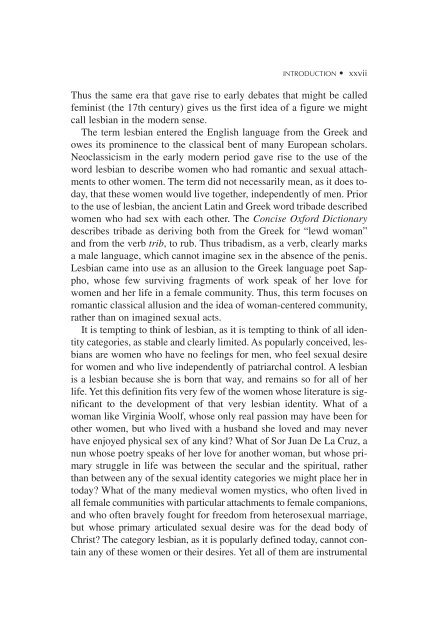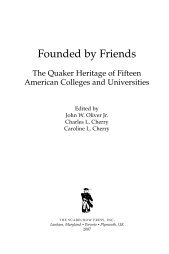Historical Dictionary of Lesbian Literature - Scarecrow Press
Historical Dictionary of Lesbian Literature - Scarecrow Press
Historical Dictionary of Lesbian Literature - Scarecrow Press
You also want an ePaper? Increase the reach of your titles
YUMPU automatically turns print PDFs into web optimized ePapers that Google loves.
INTRODUCTION • xxvii<br />
Thus the same era that gave rise to early debates that might be called<br />
feminist (the 17th century) gives us the first idea <strong>of</strong> a figure we might<br />
call lesbian in the modern sense.<br />
The term lesbian entered the English language from the Greek and<br />
owes its prominence to the classical bent <strong>of</strong> many European scholars.<br />
Neoclassicism in the early modern period gave rise to the use <strong>of</strong> the<br />
word lesbian to describe women who had romantic and sexual attachments<br />
to other women. The term did not necessarily mean, as it does today,<br />
that these women would live together, independently <strong>of</strong> men. Prior<br />
to the use <strong>of</strong> lesbian, the ancient Latin and Greek word tribade described<br />
women who had sex with each other. The Concise Oxford <strong>Dictionary</strong><br />
describes tribade as deriving both from the Greek for “lewd woman”<br />
and from the verb trib, to rub. Thus tribadism, as a verb, clearly marks<br />
a male language, which cannot imagine sex in the absence <strong>of</strong> the penis.<br />
<strong>Lesbian</strong> came into use as an allusion to the Greek language poet Sappho,<br />
whose few surviving fragments <strong>of</strong> work speak <strong>of</strong> her love for<br />
women and her life in a female community. Thus, this term focuses on<br />
romantic classical allusion and the idea <strong>of</strong> woman-centered community,<br />
rather than on imagined sexual acts.<br />
It is tempting to think <strong>of</strong> lesbian, as it is tempting to think <strong>of</strong> all identity<br />
categories, as stable and clearly limited. As popularly conceived, lesbians<br />
are women who have no feelings for men, who feel sexual desire<br />
for women and who live independently <strong>of</strong> patriarchal control. A lesbian<br />
is a lesbian because she is born that way, and remains so for all <strong>of</strong> her<br />
life. Yet this definition fits very few <strong>of</strong> the women whose literature is significant<br />
to the development <strong>of</strong> that very lesbian identity. What <strong>of</strong> a<br />
woman like Virginia Woolf, whose only real passion may have been for<br />
other women, but who lived with a husband she loved and may never<br />
have enjoyed physical sex <strong>of</strong> any kind? What <strong>of</strong> Sor Juan De La Cruz, a<br />
nun whose poetry speaks <strong>of</strong> her love for another woman, but whose primary<br />
struggle in life was between the secular and the spiritual, rather<br />
than between any <strong>of</strong> the sexual identity categories we might place her in<br />
today? What <strong>of</strong> the many medieval women mystics, who <strong>of</strong>ten lived in<br />
all female communities with particular attachments to female companions,<br />
and who <strong>of</strong>ten bravely fought for freedom from heterosexual marriage,<br />
but whose primary articulated sexual desire was for the dead body <strong>of</strong><br />
Christ? The category lesbian, as it is popularly defined today, cannot contain<br />
any <strong>of</strong> these women or their desires. Yet all <strong>of</strong> them are instrumental
















